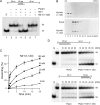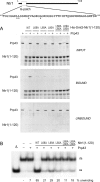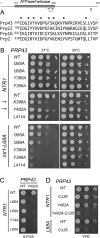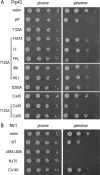Ntr1 activates the Prp43 helicase to trigger release of lariat-intron from the spliceosome
- PMID: 17875666
- PMCID: PMC1973145
- DOI: 10.1101/gad.1580507
Ntr1 activates the Prp43 helicase to trigger release of lariat-intron from the spliceosome
Abstract
DEAD/H-box NTPases remodel the spliceosome at multiple steps during the pre-mRNA splicing cycle. The RNA-dependent NTPase Prp43 catalyzes dissociation of excised lariat-intron from the spliceosome, but it is unclear how Prp43 couples the energy of ATP hydrolysis to intron release. Here, we report that activation of Prp43's inherently feeble helicase activity by the splicing factor Ntr1 is required for lariat-intron release. Lethal Prp43 mutants T384A and T384V, which are active for ATP hydrolysis and fail to dissociate lariat-intron from spliceosomes, are refractory to stimulation of RNA unwinding by Ntr1. An N-terminal 120-amino-acid segment of Ntr1 suffices for binding to Prp43 and for stimulating its helicase activity. We identify missense mutations in Prp43 and Ntr1 that disrupt protein-protein interaction and impair Ntr1 enhancement of Prp43 RNA unwinding. Our results demonstrate for the first time that regulating the motor activity of a DEAH-box protein by an accessory factor is critical for mRNA splicing.
Figures







Similar articles
-
Mutations in PRP43 that uncouple RNA-dependent NTPase activity and pre-mRNA splicing function.Biochemistry. 2006 May 23;45(20):6510-21. doi: 10.1021/bi052656g. Biochemistry. 2006. PMID: 16700561 Free PMC article.
-
The target of the DEAH-box NTP triphosphatase Prp43 in Saccharomyces cerevisiae spliceosomes is the U2 snRNP-intron interaction.Elife. 2016 Apr 26;5:e15564. doi: 10.7554/eLife.15564. Elife. 2016. PMID: 27115347 Free PMC article.
-
Spliceosome disassembly catalyzed by Prp43 and its associated components Ntr1 and Ntr2.Genes Dev. 2005 Dec 15;19(24):2991-3003. doi: 10.1101/gad.1377405. Genes Dev. 2005. PMID: 16357217 Free PMC article.
-
Structure and function of spliceosomal DEAH-box ATPases.Biol Chem. 2023 Jul 17;404(8-9):851-866. doi: 10.1515/hsz-2023-0157. Print 2023 Jul 26. Biol Chem. 2023. PMID: 37441768 Review.
-
Helicases involved in splicing from malaria parasite Plasmodium falciparum.Parasitol Int. 2011 Dec;60(4):335-40. doi: 10.1016/j.parint.2011.09.007. Epub 2011 Oct 1. Parasitol Int. 2011. PMID: 21996352 Review.
Cited by
-
DHX15 Inhibits Autophagy and the Proliferation of Hepatoma Cells.Front Med (Lausanne). 2021 Feb 11;7:591736. doi: 10.3389/fmed.2020.591736. eCollection 2020. Front Med (Lausanne). 2021. PMID: 33644083 Free PMC article.
-
The G-patch activators Pfa1 and PINX1 exhibit different modes of interaction with the Prp43 RNA helicase.RNA Biol. 2021 Apr;18(4):510-522. doi: 10.1080/15476286.2020.1818458. Epub 2020 Oct 30. RNA Biol. 2021. PMID: 32882145 Free PMC article.
-
Measuring the impact of cofactors on RNA helicase activities.Methods. 2022 Aug;204:376-385. doi: 10.1016/j.ymeth.2022.04.005. Epub 2022 Apr 14. Methods. 2022. PMID: 35429628 Free PMC article.
-
Biochemical and Genetic Evidence Supports Fyv6 as a Second-Step Splicing Factor in Saccharomyces cerevisiae.bioRxiv [Preprint]. 2023 Jan 31:2023.01.30.526368. doi: 10.1101/2023.01.30.526368. bioRxiv. 2023. Update in: RNA. 2023 Nov;29(11):1792-1802. doi: 10.1261/rna.079607.123. PMID: 36778415 Free PMC article. Updated. Preprint.
-
RNA helicase Prp43 and its co-factor Pfa1 promote 20 to 18 S rRNA processing catalyzed by the endonuclease Nob1.J Biol Chem. 2009 Dec 11;284(50):35079-91. doi: 10.1074/jbc.M109.040774. Epub 2009 Sep 29. J Biol Chem. 2009. PMID: 19801658 Free PMC article.
References
-
- Aravind L., Koonin E.V., Koonin E.V. G-patch: A new conserved domain in eukaryotic RNA-processing proteins and type D retroviral polyproteins. Trends Biochem. Sci. 1999;24:342–344. - PubMed
-
- Behzadnia N., Golas M.M., Hartmuth K., Sander B., Kastner B., Deckert J., Dube P., Will C.L., Urlaub H., Stark H., Golas M.M., Hartmuth K., Sander B., Kastner B., Deckert J., Dube P., Will C.L., Urlaub H., Stark H., Hartmuth K., Sander B., Kastner B., Deckert J., Dube P., Will C.L., Urlaub H., Stark H., Sander B., Kastner B., Deckert J., Dube P., Will C.L., Urlaub H., Stark H., Kastner B., Deckert J., Dube P., Will C.L., Urlaub H., Stark H., Deckert J., Dube P., Will C.L., Urlaub H., Stark H., Dube P., Will C.L., Urlaub H., Stark H., Will C.L., Urlaub H., Stark H., Urlaub H., Stark H., Stark H., et al. Composition and three-dimensional EM structure of double affinity-purified, human prespliceosomal A complexes. EMBO J. 2007;26:1737–1748. - PMC - PubMed
-
- Boon K.L., Auchynnikava T., Edwalds-Gilbert G., Barrass J.D., Droop A.P., Dez C., Beggs J.D., Auchynnikava T., Edwalds-Gilbert G., Barrass J.D., Droop A.P., Dez C., Beggs J.D., Edwalds-Gilbert G., Barrass J.D., Droop A.P., Dez C., Beggs J.D., Barrass J.D., Droop A.P., Dez C., Beggs J.D., Droop A.P., Dez C., Beggs J.D., Dez C., Beggs J.D., Beggs J.D. Yeast ntr1/spp382 mediates prp43 function in postspliceosomes. Mol. Cell. Biol. 2006;26:6016–6023. - PMC - PubMed
Publication types
MeSH terms
Substances
Grants and funding
LinkOut - more resources
Full Text Sources
Molecular Biology Databases
